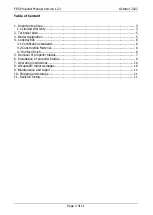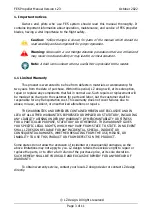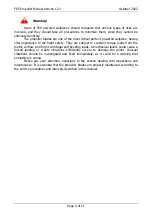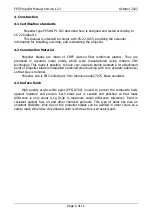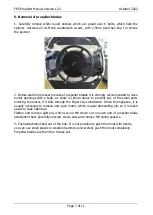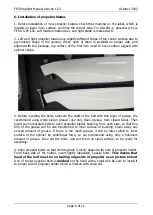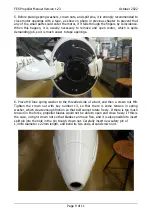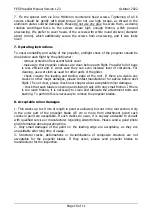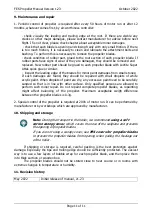
FES Propeller Manual Version 1.23
October 2022
Page 11 of 11
9. Maintenance and repair
1. Periodic control of propeller is required after every 50 hours of motor run or after 12
months, whatever comes first, by air-worthiness controller:
- check visually the leading and trailing edge at the root. If there are visible any
cracks or other major damages, please contact manufacturer for advice before next
flight. If is not clear, please check chapter about acceptable minor damages.
- check that each blade is opening and closing freely with only small friction. If there
is too much friction, it is necessary to clean and lubricate the attachment bolts and
bushing. To perform this is necessary to remove the propeller blades.
- check condition of rubber part, glued to the root section of each propeller blade. If
rubber parts have signs of wear or they are damaged, they should be removed and
replaced. New rubber part should be glued to each propeller blade with Loctite Super
Attak quick glue or similar.
- inspect the leading edge of the blades for minor paint damages from small stones;
If such damages are found, they should be repaired with small droplets of white
acrylic paint. When droplets of paint are dry, any excessive paint need to be carefully
sanded so that is in line with other surface. Only qualified persons are allowed to
perform such minor repair. Do not repaint complete propeller blades, as repainting
might affect balancing of the propeller. Maximum acceptable weigh difference
between the propeller blades is 0.3g.
2. Special control of the propeller is required at 200h of motor run. It can be performed by
manufacturer or by workshops which are approved by manufacturer.
10. Shipping and storage
Note:
During the transport in the trailer, we recommend
using a soft
cotton canopy cover
, which covers the nose of the sailplane and prevents
the opening of propeller blades.
If you are not using a canopy cover, use
FES covers for propeller blades
to prevent the propeller blades from opening when pulling the fuselage out
of the trailer.
If shipping or storage is required, careful packing is the best protection against
damage. Especially the tips and trailing edge should be sufficiently protected. The easiest
way is to use a few layers of bubble wrap for each propeller blade, and then place them
into thick cartoon or wooden box.
The propeller blades should not be stored close to heat source or in rooms with
extreme changes in temperature or humidity.
11. Revision history
May 2022
Initial release of manual, v1.23


